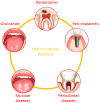Role of Oral Microbiota Dysbiosis in the Development and Progression of Oral Lichen Planus
- PMID: 38673013
- PMCID: PMC11050998
- DOI: 10.3390/jpm14040386
Role of Oral Microbiota Dysbiosis in the Development and Progression of Oral Lichen Planus
Abstract
Oral lichen planus (OLP) is a chronic inflammatory autoimmune disease of the oral cavity with malignant potential affecting 1.01% of the worldwide population. The clinical patterns of this oral disorder, characterized by relapses and remissions of the lesions, appear on buccal, lingual, gingival, and labial mucosa causing a significant reduction in the quality of life. Currently, there are no specific treatments for this disease, and the available therapies with topical and systemic corticosteroids only reduce symptoms. Although the etiopathogenesis of this pathological condition has not been completely understood yet, several exogenous and endogenous risk factors have been proposed over the years. The present review article summarized the underlying mechanisms of action involved in the onset of OLP and the most well-known triggering factors. According to the current data, oral microbiota dysbiosis could represent a potential diagnostic biomarker for OLP. However, further studies should be undertaken to validate their use in clinical practice, as well as to provide a better understanding of mechanisms of action and develop novel effective intervention strategies against OLP.
Keywords: autoimmune disease; biomarker; inflammation; oral cavity; oral diseases; oral dysbiosis; oral lichen planus; oral microbiota; squamous-cell carcinoma.
Conflict of interest statement
The authors declare no conflicts of interest.
Figures
Similar articles
-
Oral Microbiome Research on Oral Lichen Planus: Current Findings and Perspectives.Biology (Basel). 2022 May 9;11(5):723. doi: 10.3390/biology11050723. Biology (Basel). 2022. PMID: 35625451 Free PMC article. Review.
-
Cytokines Levels and Salivary Microbiome Play A Potential Role in Oral Lichen Planus Diagnosis.Sci Rep. 2019 Dec 2;9(1):18137. doi: 10.1038/s41598-019-54615-y. Sci Rep. 2019. PMID: 31792433 Free PMC article.
-
Demographic and clinical profile of oral lichen planus: A retrospective study.Contemp Clin Dent. 2013 Apr;4(2):181-5. doi: 10.4103/0976-237X.114873. Contemp Clin Dent. 2013. PMID: 24015006 Free PMC article.
-
Evaluation of Potential Risk Factors that contribute to Malignant Transformation of Oral Lichen Planus: A Literature Review.J Contemp Dent Pract. 2016 Aug 1;17(8):692-701. doi: 10.5005/jp-journals-10024-1914. J Contemp Dent Pract. 2016. PMID: 27659090 Review.
-
Oral Lichen planus.J Biol Regul Homeost Agents. 2018 Mar-Apr;32(2):391-395. J Biol Regul Homeost Agents. 2018. PMID: 29685024
Cited by
-
Etiopathogenesis of Oral Lichen Planus: A Review.Head Neck Pathol. 2025 Jun 6;19(1):73. doi: 10.1007/s12105-025-01807-w. Head Neck Pathol. 2025. PMID: 40478312 Review.
-
The Impact of Oral Microbiome Dysbiosis on the Aetiology, Pathogenesis, and Development of Oral Cancer.Cancers (Basel). 2024 Aug 28;16(17):2997. doi: 10.3390/cancers16172997. Cancers (Basel). 2024. PMID: 39272855 Free PMC article. Review.
-
Editorial: Exploring oral microbiota dysbiosis as a risk factor for oral and non-communicable diseases.Front Oral Health. 2025 Apr 25;6:1611120. doi: 10.3389/froh.2025.1611120. eCollection 2025. Front Oral Health. 2025. PMID: 40351789 Free PMC article. No abstract available.
-
DnaK of Parvimonas micra extracellular vesicles interacts with the host fibroblasts BAG3-IKK-γ axis to accelerate TNF-α secretion in oral lichen planus.Microbiome. 2025 Jul 14;13(1):164. doi: 10.1186/s40168-025-02151-5. Microbiome. 2025. PMID: 40660385 Free PMC article.
References
-
- GBD 2019 Lip, Oral, and Pharyngeal Cancer Collaborators. Cunha A.R.D., Compton K., Xu R., Mishra R., Drangsholt M.T., Antunes J.L.F., Kerr A.R., Acheson A.R., Lu D., et al. The Global, Regional, and National Burden of Adult Lip, Oral, and Pharyngeal Cancer in 204 Countries and Territories: A Systematic Analysis for the Global Burden of Disease Study 2019. JAMA Oncol. 2023;9:1401–1416. - PMC - PubMed
Publication types
LinkOut - more resources
Full Text Sources



